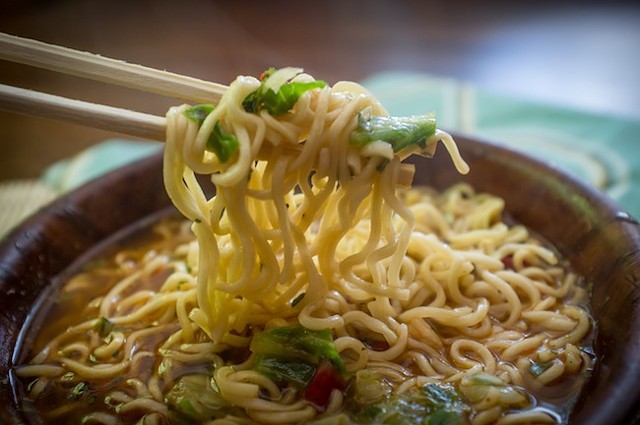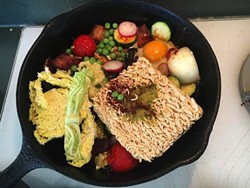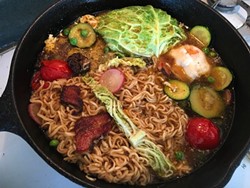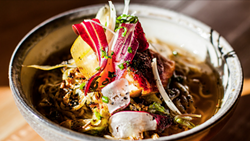On the fifth floor of the apartment building where I grew up, my young culinary horizons were broadened by a Korean family down the hall. By second grade, I could hold a bowl of rice to my mouth and shovel it in with chopsticks, thanks to the diligent coaching of Christina, Wendy and Karen, who were about my age. The Park girls also taught me how to carefully pull noodles, one by one, from a bowl of high-end Japanese instant ramen.
Sometimes their parents doctored the ramen with the likes of seaweed, green onion and egg. It hampered the noodle games, but by college I had some valuable life skills, along with disdain for my dormies and their cases of Top Ramen, to which they proudly added hot dogs and canned chicken.

- (Photo by Ezumel Images)
Today, I doctor with produce from the farmers market, but I still use the Park family's instant ramen of choice: a Japanese brand called Sapporo Ichiban.
Japan is the undisputed birthplace of ramen, but nearby Korea never developed a culture of ramen bars, those storied humble kitchens where fresh noodles are served in slowly-simmered broth. Without that background, most Korean eaters, like their American counterparts, first experienced ramen in packaged, instant form.
Since my early education, ramen is having an extended moment, and Korea has been a leader in this worldwide phenomenon. The land that gave us K-pop produces some of the most over-the-top versions of packaged ramen, with multiple flavoring packs delivering spices, oils and freeze-dried proteins and vegetables. But the favored brand among South Koreans, since about the mid-1980s, is Shin Ramyun, a simple, spicy beef broth-based formulation that's become an iconic South Korean comfort food.
During these hot days of summer, piquancy is an unexpected asset to a hot bowl of brothy ramen, as temperature-heat and spicy-heat combine like a double negative to create their polar opposite. Your face gets steamed as the hydrating liquids warm your belly, while the chile heat lights a refreshing kind of fire inside, making you sweat profusely, which cools you off dramatically. While chilled soups get a lot of attention in the sweltering heat, they aren't eating gazpacho in the infernos of Bangkok, Saigon, Chengdu and other hot Asian places where the soups are hot, spicy and brothy, not to mention full of noodles.
In addition to cooling off, I like to use spicy ramen as a way to absorb seasonal vegetables as they appear. Wild dandelion and nettle ramen during mud season, pea and zucchini ramen in spring, which, in turn, give way to the umami rich tomatoes and corn.
In this country, most fresh ramen — the kind served at the places where hipsters wait in lines around the block — includes a choice of miso, soy base, or tonkatsu (aka pork bone) broth. When it comes to instant, I actually prefer the chicken or regular flavors of Sapporo Ichiban. But regardless of noodle brand and even flavor, I like to carry on the tonkatsu tradition of adding bacon and eggs to the ramen, but a Korean may use beef ribs instead of bacon, and that's totally fine.

- Before (Photo by Ari LeVaux)
Different ingredients must be added at different times, depending on how long they need to cook. I start with bacon (just a basic flavor, no honey or maple — I like pancetta). Cook slowly on low to make it a little crispy, and leave yourself time to remember ingredients you want to add. Then, anything else that may benefit from some time simmering in bacon grease. Mushrooms are one option, though I think you would want to add butter, which is just fine in ramen. Zucchini, radish and garlic are also good early additions. Tomatoes can be added then, so they have time to spill their juices, along with half an onion, which can add flavor but be easily avoided later on. Toasted sesame oil adds a great flavor to most ramen, and now is as good a time as any to add it. Stir it around to even out the brown, and place the dry brick of noodles atop everything else in the pan, and cover. This gets the noodles cooking, ever so slightly, in the steam of the simmering veggies. Meanwhile, start a kettle of water on the stove.
When the water boils, add the last round of ingredients to the pan. In my case, that includes a cracked egg and maybe some tofu. Sprinkle the flavor packet onto the stuff in the pan, along with an appropriate amount of chile powder, if using, and pour in the water. I like it brothy, so I add a cup or more than I'm supposed to.
The water will continue to boil as you add it to the pan, and will create a bit of a steam. Now you can add anything that needs just a bit of cooking, such as peas, corn or pieces of cabbage. Pea shoots will get tangled up in the noodles, which is fun. You can also add mustard greens, frozen shrimp or scallops, meat from a rotisserie chicken, or anything else that could use a little cooking, or add to the broth. Make sure noodles are submerged. It should take about two minutes of the noodles to cook, then kill the heat.

- After (Photo by Ari LeVaux)
Taste the broth and add seasoning sauces. I like a dash of fish sauce, a splash of soy, a tablespoon of oyster sauce, but it changes depending on the soup base. If I'm using beef-flavored seasoning I add hoisin sauce. Sometimes a little black pepper is nice. Cook for a minute, covered, and serve alongside a garnish plate of raw veggies to add on top.
These garnish veggies include fresh herbs, radicchio, green onions, seaweed, fresh cucumber slices, iceberg lettuce and even slices or wedges of low-acid heirloom tomatoes like brandywine. These veggies may wilt a bit in the heat, but will still provide a fresh crunch. The Koreans, of course, like to add kim chi.
Last but not least, the spices. I recommend sliced jalapeños and a squirt of sriracha, but there are many ways to add heat to a bowl of noodles; chile powder (added already), for example, or adding your favorite hot sauce while eating.
As the sweat drips and the back of your neck begins feeling pleasantly cool, remember that loud slurping is a sign of respect to the chef in authentic ramen houses. So let your inhibitions go and dive in. Heck, I won't even complain if you add some mayo. Just remember to bring a towel.
And if you're not interested in making all that effort, check out the list below for some great places to find ramen and similar dishes in Charlotte.
Queen City's Ramen Radar
Yama Izakaya
1324 Central Ave.
Following the traditional style of Japanese taverns — called izakaya — Yama Izakaya invites guests to come hang out for a drink and some health-conscious food after work. The menu boasts creative sushi rolls and of course, steaming bowls of ramen. Along three styles of ramen to choose from: tonkatsu, shio and miso, there's also plenty of add-ons to make your ramen experience unique to your palate.

- A Futo Buta ramen bowl. (Photo courtesy of Futo Buta)
Futo Buta
222 E. Bland St.
Focusing mostly on ramen bowls, Futo Buta's limited menu leaves nothing to be desired. Just perusing through the options of shoyu, miso, niwa and chizu ramen combinations is mouth-watering enough to head over for a delicious meal. That doesn't mean they don't know about Southern palates, as they also offer pecan smoked pork options in their ramen menu.
Musashi
10110 Johnston Rd.
Although Musashi only offers three different styles of ramen, they also back it up with a menu of udon and soba options that lands them on our Ramen Radar. Make the trip out to South Charlotte and branch out from traditional ramen bowls to try something enticing — perhaps tempura soba with fresh seaweed and sesame dressing.
Soul Gastrolounge
1500 Central Ave.
This cozy Plaza Midwood eatery dabbles in a variety of cuisines. And while they boast traditional menu options such as sashimi and sushi rolls, Soul Gastrolounge's twist on a traditional ramen bowl gives it a spot on this list. Garlic cream, braised veal cheeks, goat cheese, fried mushrooms and caramelized onions come together to deliver a ramen bowl like you've never had before.
Nikko Japanese Restaurant & Sushi Bar
325 Arlington Ave.
Black pork belly and all the fixings go into Nikko's traditional ramen bowls, but that doesn't mean its an underdog on our Ramen Radar. With a DJ on some weekend nights, the place gets jumping and becomes a go-to stop for some ramen, udon and soba to fuel you up on a Friday or Saturday night.
